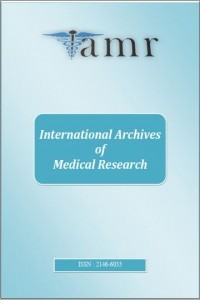High c-peptide level: marker of mortality in type 2 diabetes mellitus patients
High c-peptide level: marker of mortality in type 2 diabetes mellitus patients
Diabetes mellitus, c-peptide,
___
- 1- American Diabetes Association. Diagnosis and classification of diabetes mellitus. Diabetes Care. 2013 Jan;36 Suppl 1:S67-74. doi: 10.2337/dc13-S067.
- 2- Steiner DF, Cunningham D, Spigelman L, Aten B. Insulin biosynthesis: evidence for a precursor. Science 1967;157:697–700.
- 3- Wahren J, Ekberg K, Jörnvall H. C-peptide is a bioactive peptide. Diabetologia 2007; 50:503–509.
- 4- Zhang W, Kamiya H, Ekberg K, Wahren J, Sima AA. C-peptide improves neuropathy in type 1 diabetic BB/Wor-rats. Diabetes Metab Res Rev. 2007 Jan;23(1):63-70.
- 5- Vasic D, Marx N, Sukhova G, et al. C-peptide promotes lesion development in a mouse model of arteriosclerosis. J Cell Mol Med 2012; 16: 927–935.
- 6- Marx N, Walcher D, Raichle C, et al. C-peptide colocalizes with macrophages in early arteriosclerotic lesions of diabetic subjects and induces monocyte chemotaxis in vitro. Arterioscler Thromb Vasc Biol 2004; 24: 540–545.
- 7- Walcher D, Babiak C, Poletek P, et al. C-Peptide induces vascular smooth muscle cell proliferation: involvement of SRC-kinase, phosphatidylinositol 3-kinase, and extracellular signal-regulated kinase 1/2. Circ Res 2006; 99: 1181–1187.
- 8- Pikkemaat M, Melander O, Mölstad S, Garberg G, Boström KB. C-peptide concentration, mortality and vascular complications in people with Type 2 diabetes. The Skaraborg Diabetes Register. Diabet Med. 2015 Jan;32(1):85-9. doi:10.1111/dme.12608.
- 9- Nawal C L, Goyal LK, Kumar V, Gautam A, Agrawal A, Mital P. Serum C-peptide level as a predictor of atherosclerosis and cardiovascular disease in type 2 diabetes mellitus. J Mahatma Gandhi Inst Med Sci 2016;21:25-9
- 10- Irwin ML, Duggan C, Wang CY, et al. Fasting C-peptide levels and death resulting from all causes and breast cancer: the health, eating, activity, and life style study. J Clin Oncol 2011; 29:47 – 53.
- 11- Vasic D, Marx N, Sukhova G, et al. C-peptide promotes lesion development in a mouse model of arteriosclerosis. J Cell Mol Med 2012; 16: 927–935.
- 12- Rask-Madsen C and King GL. Vascular complications of diabetes: mechanisms of injury and protective factors. Cell Metab 2013; 17: 20–33.
- 13- Nikolaus Marx, Guenther Silbernagel, Vincent Brandenburg, et al. Diabetes Care. 2013 Mar; 36(3):708-14
- 14- Flavio E. Hirai, MPH, Scot E. Moss, MA, Barbara E.K. Klein, Ronald Klein, Diabetes Care. 2008 Mar; 31(3):493-7.
- ISSN: 2146-6033
- Yayın Aralığı: Yılda 2 Sayı
- Başlangıç: 2011
- Yayıncı: Veysi AKPOLAT
Nida ÖZCAN, Nezahat AKPOLAT, Selahattin ATMACA, Kadri GÜL
High c-peptide level: marker of mortality in type 2 diabetes mellitus patients
Çiğdem Budak ECE, Zafer PEKKOLAY, Alpaslan Kemal TUZCU
Color and Tissue Doppler Echocardiographical Findings in Patients with Rheumatoid Arthritis
Mehmet CAGLAYAN, Ali Fuat KARA, Mehmet Zihni BİLİK, Mehmet Ata AKIL, Figen Ceylan ÇEVİK, Remzi ÇEVİK
